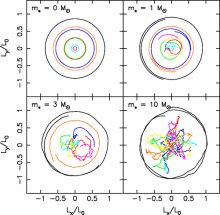
Abstract
The spin and quadrupole moment of the supermassive black hole at the Galactic center can in principle be measured via astrometric monitoring of stars orbiting at milliparsec (mpc) distances, allowing tests of general relativistic "no-hair" theorems (Will 2008). One complicating factor is the presence of perturbations from other stars, which may induce orbital precession of the same order of magnitude as that due to general relativistic effects. The expected number of stars in this region is small enough that full N-body simulations can be carried out. We present the results of a comprehensive set of such simulations, which include a post-Newtonian treatment of spin-orbit effects. A number of possible models for the distribution of stars and stellar remnants are considered. We find that stellar perturbations are likely to obscure the signal due to frame-dragging for stars beyond ~0.5 mpc from the black hole, while measurement of the quadrupole moment is likely to require observation of stars inside ~0.2 mpc. A high fraction of stellar remnants, e.g. 10-Solar-mass black holes, in this region would make tests of GR problematic at all radii. We discuss the possibility of separating the effects of stellar perturbations from those due to GR.